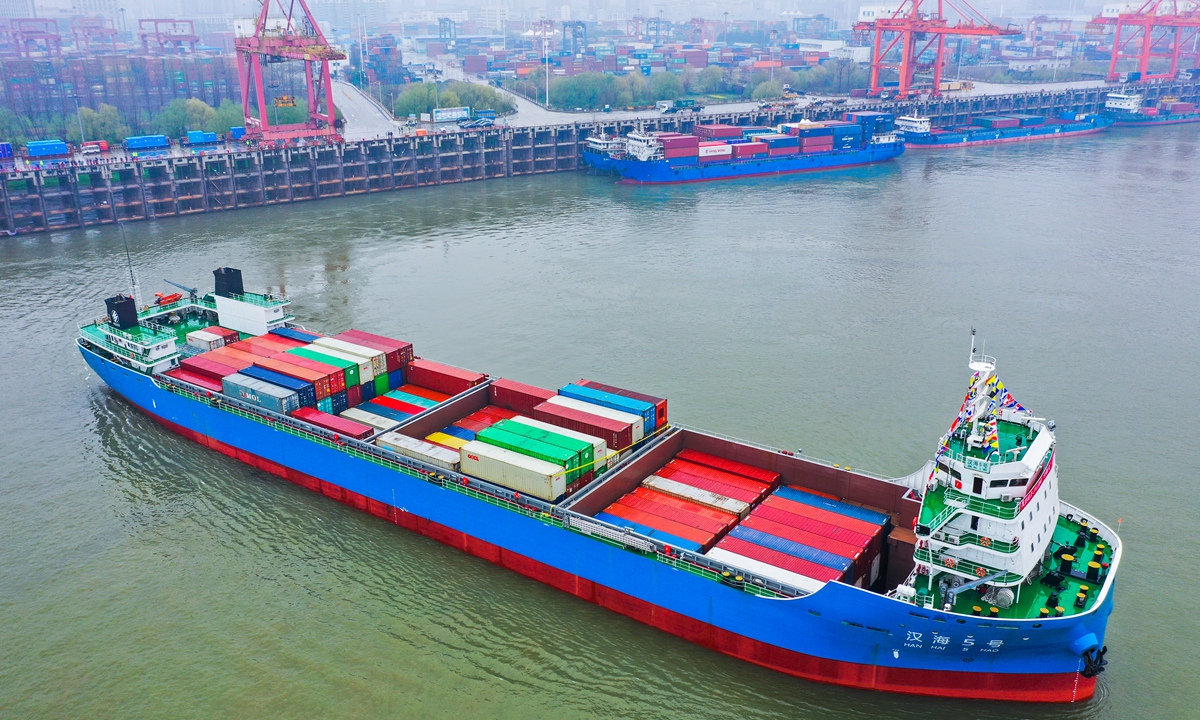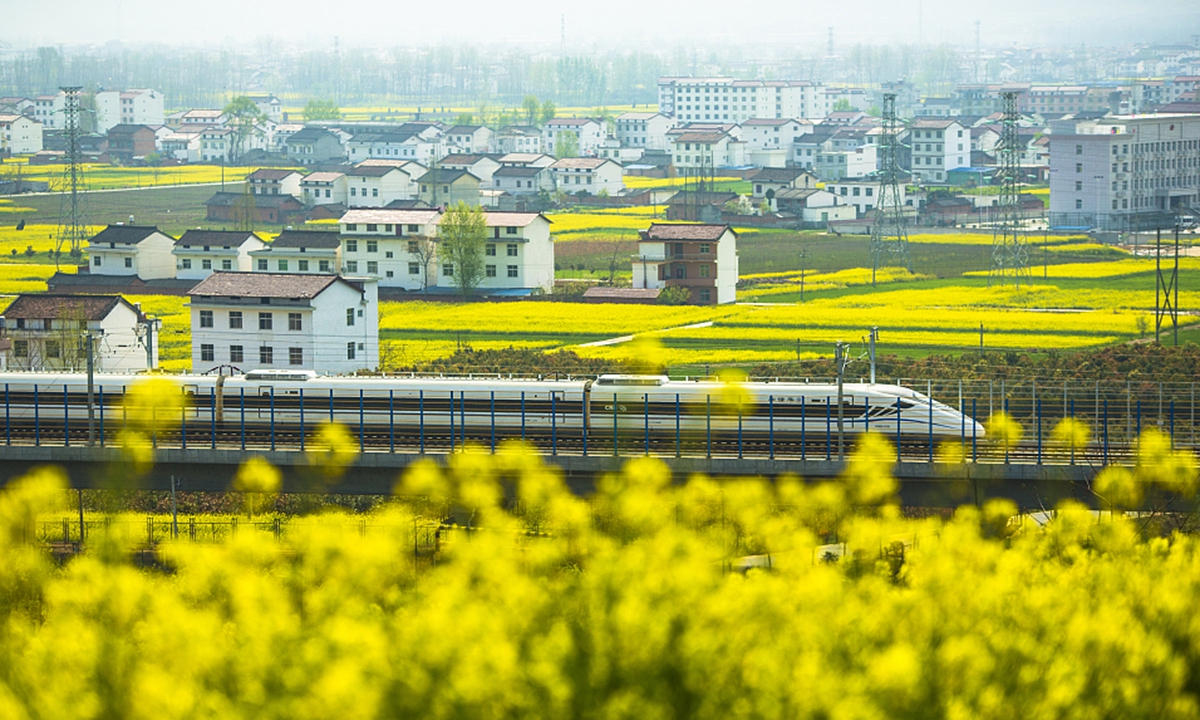
A container vessel sails away from the Port of Wuhan, Central China’s Hubei Province bound for Shanghai along the Yangtze River. The ship is loaded with medical supplies, machinery equipment, flat glass, optic fibers and tea slated for export markets. The vessel is one of the most advanced linking the central China river port with the sea, as China develops the Yangtze River economic belt that accounts for 46.6 percent of the nation’s economic output. Photo: VCG
As thousands of China's top legislators and political advisors prepare to convene in Beijing later this week for the annual two sessions, they are tasked to review and discuss various policy priorities and sweeping development plans designed to further lift the country to new milestones in the next 15 years: a modern socialist power with world-leading national strength and global influence.
The annual legislative and political consultative sessions are usually a window into policy agenda and various economic and social development targets for the year. But coming at a crucial inflection point, as the country transitions into a new five-year plan and longer development visions, this year's meeting will also provide a clear direction and blueprint of where the world's second-largest economy is headed, following decades of rapid growth and mounting internal and external risks. That would follow a precedence set in 2020, when China did not set a specific target for the first time in decades.
One of the most closely-watched items on the agenda is China's official GDP growth target. But in keeping with the country's shifting focus toward quality over quantity and reflecting mounting uncertainties, a specific numerical GDP target this year may not be released at the two sessions and instead put more emphasis on jobs, consumer prices, fiscal and monetary policies as well as risk aversion, some analysts said.
However, others noted that certain types of growth, such as a range or a growth floor of 6 percent, could be adopted to better coordinate policy and offer guidance and a longer-term goal to become a mid-income country by 2035 could imply an average annual growth of about 5 percent in the next 15 years.
Growth targetGrowth targets and other policy priorities will be contained in a Government Work Report to be delivered at the opening session of the National People's Congress (NPC), the top legislative body, which is scheduled for Friday. Deputies to the NPC and members of the Chinese People's Political Consultative Conference (CPPCC) National Committee, which will open its annual session on Thursday, will then discuss and review the report before adopting it at the end of the meeting.
Expected in the report to be delivered by Premier Li Keqiang are a slew of social and economic development targets, which usually include GDP growth, inflation rate, new job creations, and unemployment and budget deficit. It remains unclear whether a GDP growth target will be released in the report, but some economists and institutions said that a specific numerical one is unlikely to be released given the shifting focus in policy priority and mounting uncertainties.
"There are different views on setting a GDP growth target, but it's more likely that a target would not be released," Guan Tao, chief global economist at BOC International (China) and a former senior official at the State Administration of Foreign Exchange, told the Global Times on Tuesday, adding that setting a specific target would enhance the stress on speed, while the country aims for high-quality.
Facing uncertainties brought by the COVID-19 pandemic, China skipped setting a numerical GDP growth target in 2020. The country has also been adopting a target range instead of a specific one over the past several years amid external risks.
As the Chinese economy mounted a remarkable rebound from the pandemic in 2020 with a 2.3 percent growth - the only expansion among major economies - and the recovery is expected to further pick up pace, there is no need to set up a target, according to Su Jian, director of the National Center for Economic Research at Peking University.
"Because growth will be very high this year, it is unnecessary to set such a target," Su told the Global Times on Tuesday, adding that the focus of macro policies is on protecting jobs and preventing risks.

Photo:VCG
Economists and institutions have predicted that the Chinese economy could grow over 8 percent in 2021, due to a low base in 2020 and further recovery momentum.
Still, some say that a target is needed for the country to pursue longer-term development goals. Yang Weimin, a member of the 13th CPPCC National Committee and renowned economist, said that "from the perspective of achieving the goal of a modernized country in the future, it is still necessary to set a growth rate target this year," according to China News Services. Yang did not say what target China should set.
Standard Chartered said that China may adopt a growth floor of 6 percent for 2021, according to a research note shared with the Global Times on Tuesday.
"Whether a number is released publicly or not, there are certainly targets for the government to coordinate various policies, including investments, debts and deficit," Tian Yun, vice director of the Beijing Economic Operation Association, told the Global Times on Tuesday. But the overall trend is that the focus will be shifted toward areas that directly linked to people's livelihood, with jobs, consumer prices and other issues drawing much attention.
In line with tradition, China will likely set specific targets for those areas at the two sessions, analysts said. Last year, China sets target for new job creation at 9 million, CPI growth at 3.5 percent and deficit ratio at around 3.6 percent - all targets were met, the People's Bank of China said on Tuesday. Analysts said those targets will likely be further improved this year given the better economic conditions.
Bold goals While targets and policy priority for 2021 are in the spotlight, there are also broader and bolder long-term social and economic developments goals for the world's second-largest economy to be watched during the two sessions.
Topping the agenda for the two sessions this year are discussions on the 14th Five-Year Plan (2021-25) and the long-range objectives through 2035. Early suggestions for the plan have indicated that China is aiming to become a mid-income country and double its 2020 GDP in 2035. That would require an average annual growth rate of between 4.7 percent and 5 percent in the next 15 years, according to some calculations.
"Though the development plan does not include specific numerical targets, there are many specific goals implied so that we can keep track on our work and policies," Cao Heping, a professor at the School of Economics of Peking University, told the Global Times on Tuesday, noting that it was "reasonable" for the Chinese economy to grow at 5 percent on average through 2035.
Also at core for the 14th Five-Year Plan and the long-range objectives through 2035 are the ability to make breakthroughs in core technologies to reach tech independence, as the US is escalating a tech race with China. Discussions over breaking the tech "bottleneck" has already become a hot topic ahead of the two sessions, with analysts and markets expecting major policy support and development plans following the two sessions. The Ministry of Industry and Information Technology said on Monday that it was drafting a plan to tackle areas of shortcomings and weakness.
Also in focus at this year's two sessions is a campaign to combat monopolies and what officials call "disorderly expansion of capital," as regulations have been tightened for the online financial and fintech sectors in recent months.
"GDP growth remains a hot topic, but [another theme] of the two sessions is curbing risks, including in the financial sector, housing market, banking and external impact," Guan said.
In a preview of talks over financial de-risk at the two sessions, Guo Shuqing, head of the China Banking and Insurance Regulatory Commission, issued stern warnings of bubbles in the country's financial and housing market, and foreign markets.





